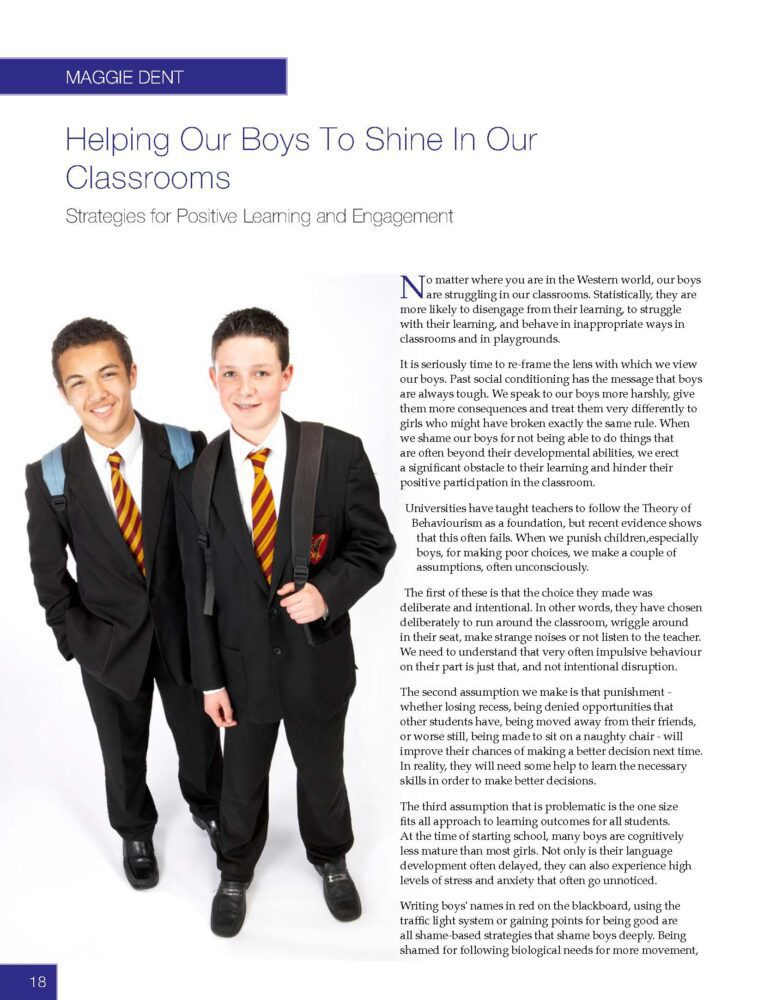Posts for Teachers, Teachers Matter
Helping our boys to shine in our classrooms

First published in Teachers Matter magazine, Issue 58, 2023.

No matter where you are in the Western world, our boys are struggling in our classrooms. Statistically, they are more likely to disengage from their learning, to struggle with their learning, to behave in inappropriate ways in classrooms and in playgrounds.
It is seriously time to re-frame the lens with which we view our boys. Past social conditioning has the message that boys are always tough. There is no question that our boys are spoken to more harshly, given more punishments and treated very differently to girls who do exactly the same thing. When we shame our boys for being unable to do things that they are often developmentally unable to do, we create a massive barrier to their learning and positive participation in the classroom.
Behaviourism, which has long been the foundation taught in universities for teachers to follow, has now been shown to fail often. When we punish children for making poor choices, especially boys, we make a couple of assumptions often unconsciously. The first of these, is that the choice they made was deliberate and intentional. In other words, they have chosen deliberately to run around the classroom, wriggle around in their seat, make strange noises or not listen to the teacher. So often, impulsive behaviour, is just that impulsive behaviour and not intentional.
The second assumption we make is that punishment – whether losing recess, being denied opportunities that other students have better fun based, being moved away from their friends, or worse still, made to sit on a naughty chair – will improve their chances of making a better decision next time. They will need some help to learn better skills to make better decisions.
The third assumption that is problematic is the one size fits all approach to learning outcomes for all students. In transition to big school, many boys are cognitively less mature than most girls. Not only that the language development is often delayed, and they can experience high levels of stress and anxiety that go unnoticed.
Writing boys names in red on the blackboard, or using the traffic light system or gaining points for being good are all shame-based strategies that shame boys deeply. Being shamed for following biological needs for more movement, for being unable to stay focused when too many words are being spoken, or struggling to follow long directions, creates enormous stress for boys of all ages.
Not only does it create a sense of being a failure, being shamed damages the relationship with the teacher. When boys feel that their teacher likes them, they strive very hard to do their best. In many ways, they learn through the teacher rather than any subject being taught. When they are feeling shamed and emotionally hurt, they withdraw their capacity to feel safe and this triggers more anxiety.
Stress behaviours can come out, especially in the fight and flight space as aggression, shouting, meltdowns, running away, throwing things, being oppositional and even excessive silliness. As Dr Mona Delahooke explains in her ground breaking book Beyond Behaviours, often these behaviours are physiologically driven from an overwhelmed state within the nervous system. These behaviours are a sign that the child’s physical or emotional needs are not being met in that environment, not that the child is deliberately choosing to behave that way. How often do we see that as being naughty, especially for boys? In a way they are trying to regulate the floods of cortisol that they are experiencing in the moment. Our expectation is that young children have the ability to control their emotions and behaviours as children, is incomprehensible given that it takes until early adult hood for these abilities to fully develop. –
There are three zones that Dr Delahooke explores that are based on the research of Stephen Porges and his Polyvagal theory are the green zone – where children are calm, focused and alert and are capable of social engagement. The second zone is the fight flight where those outwardly uncomfortable behaviours can appear. The third is the blue zone commonly known as a freeze zone and can often be harder to detect because children often shut down, withdraw, daydream, or look like they are not listening. This is still a heightened state of stress.
When classrooms have space for movement, have fun and lightness, regular relaxation and mindfulness, warm communication, gestures of kindness and use discipline that teaches and guides rather than punishes – all students can thrive and shine especially our boys.
How can we help boys in our classrooms;
- build a warm relationship with them
- respect the need for movement
- ensure you have moments of calmness and relaxation
- stop punishing and shaming boys – discipline instead
- recognising that gender differences can impact developmental expectations



